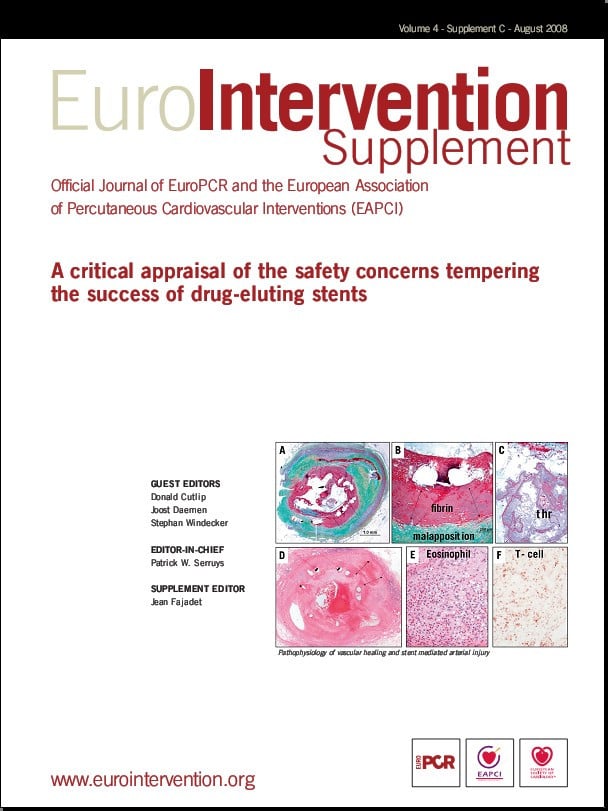Abstract from the REAL registry
Abstract
Background: The long-term safety and efficacy of drug-eluting stents (DES) have been questioned recently.
Methods and results: Between July 2002 and June 2005, 10,629 patients undergoing elective percutaneous coronary intervention with either DES (n=3064) or bare-metal stents (BMS, n=7565) were enrolled in a prospective registry comprising 13 hospitals. We assessed the cumulative incidence of major adverse cardiac events (death, acute myocardial infarction, and target-vessel revascularisation) and angiographic stent thrombosis during 2-year follow-up. A propensity score analysis to adjust for different baseline clinical, angiographic, and procedural characteristics was performed. The 2-year unadjusted cumulative incidence of major adverse cardiac events was 17.8% in the DES group and 21.0% in the BMS group (P=0.003 by log-rank test). Angiographic stent thrombosis was 1.0% in the DES group and 0.6% in the BMS group (P=0.09). After adjustment, the 2-year cumulative incidence of death was 6.8% in the DES group and 7.4% in the BMS group (P=0.35), whereas the rates were 5.3% in DES and 5.8% in BMS for acute myocardial infarction (P=0.46), 9.1% in DES and 12.9% in BMS for target-vessel revascularisation (P<0.00001), and 16.9% in DES and 21.8% in BMS for major adverse cardiac events (P<0.0001). Independent predictors of target-vessel revascularisation in the DES group were diabetes mellitus (hazard ratio 1.36, 95% confidence interval 1.06 to 1.76), renal failure (hazard ratio 1.69, 95% confidence interval 1.06 to 2.69), and reference vessel diameter (hazard ratio 0.64, 95% confidence interval 0.45 to 0.93).
Conclusions: In this large real-world population, the beneficial effect of DES in reducing the need for new revascularisation compared with BMS extends to 2 years without evidence of a worse safety profile.
(Circulation 2007;115:3181-3188.)© 2007 American Heart Association, Inc.
Acknowledgement
Reprinted from Circulation 2007 Jun 26;115(25):3181. with permission from Lippincott Williams & Wilkins, Medical Research a division of Wolters Kluwer Health, Inc.
Commentary on the REAL registry
The first impressions that I had when I read the report of the REAL Registry (REgistro AngiopLastiche dell’Emilia Romagna) were:
– This Registry is REAL, not only for the name, but also for the data reported because it reflects the actual patient population treated with drug-eluting stents (DES) in daily practice.
– The patients treated with DES had an overall higher risk profile compared to patients treated with bare-metal stents (BMS).
When I examine Tables 1 and 2 in addition to the large number of patients evaluated (7,565 patients treated with BMS and 3,064 patients treated with DES), I notice important features such as diabetes, unstable angina, prior myocardial infarction, prior by-pass surgery and prior percutaneous interventions which are present in both groups and in particular 30.7% of the patients treated with DES vs. 22.4% of patients treated with BMS had diabetes mellitus (p<0.0001). The only group of patients excluded from this registry were the ones presenting with ST-elevation myocardial infarction, I agree with this decision because these patients represent a very unique category. Multivessel intervention was performed in 21% of the patients in the two groups.
Regarding the lesions characteristics, I acknowledge the presence of many high risk lesions more frequently in patients treated with DES: bifurcations were treated more frequently with DES (20.3% versus 13.3%, P<0.0001), ostial lesions (11.8% versus 6.3%, P<0.0001), long lesions (lesion length >20 mm; 40.6% DES versus 22.5% BMS, P<0.0001), and small vessels (average reference vessel diameter 2.8±0.4 versus 3.1±0.5 mm, P<0.0001).
The authors performed a sophisticated analysis using the propensity score in order to balance for differences between the two groups. Before addressing this issue, I would like to look at the unadjusted results. I think it is very important to examine the “crude results” in detail and maintain a sense of suspicion when the adjusted results go in the opposite direction to the unadjusted ones. I am happy to observe that this phenomena does not occur in the REAL Registry.
The most important findings are summarised in Table 3: all most relevant majors adverse events such as death and myocardial infarction are more frequent or similar in patients treated with BMS compared to patients treated with DES, if we consider the more unfavourable risk profile of patients treated with DES. I think we do not need to look at the adjusted analysis: the conclusions could already be drawn.
Regarding target lesions revascularisation (TLR), the small difference favouring DES is most probably due to the much higher risk profile of the lesions treated with DES as well as the lack of a compulsive evaluation for residual ischaemia during follow-up. Very similar findings have been reported in the Ontario Registry1, with the difference being that in the REAL Registry the selection between low-risk and high-risk lesions has been done by the physicians as BMSs were implanted in relatively low risk lesions – as is done the “REAL” world practice in Europe – whereas in the Ontario Registry, similar conclusions were observed following the retrospective “statistical analysis”.
The only area of concern is the two year incidence of angiographic stent thrombosis which is 0.6% in patients treated with BMS and 1% in patients treated with DES (p=0.09). The main contribution to this slight increase is given by late – and in particular – very late stent thrombosis (0.1% vs. 0.4% In patients treated with DES, p=0.01). These numbers are very small, and it may be that the 0.4% higher incidence in stent thrombosis is a small price to pay for all the other benefits, including a slight reduction in cardiac death and a modest reduction in TLR. Despite this optimism, I would like to see further improvements such a similar or even lower risk of stent thrombosis with DES compared to BMS. We should not forget that patients treated with DES were maintained on clopidogrel for a long time period. Unfortunately the REAL Registry does not give us detailed information concerning this area.
In the end, it is reassuring to know that we are not harming our patients, still we cannot deny that we should do better.

